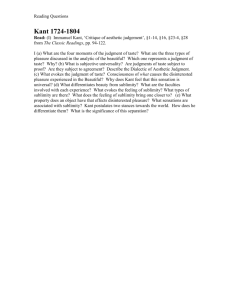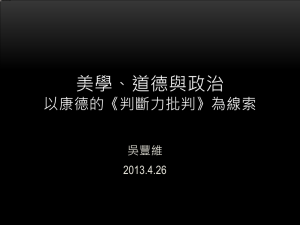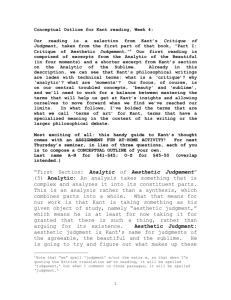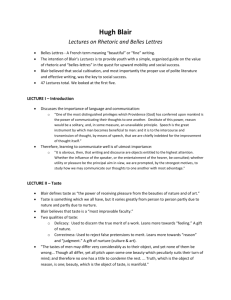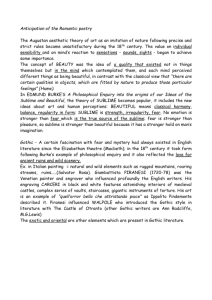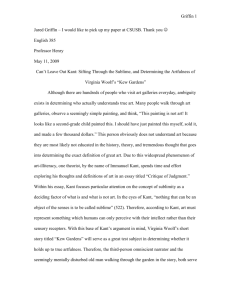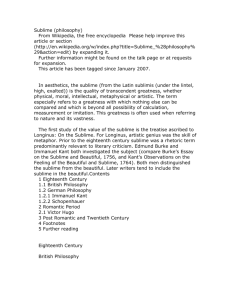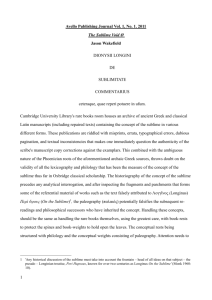Dialectic of Aesthetic Judgment
advertisement
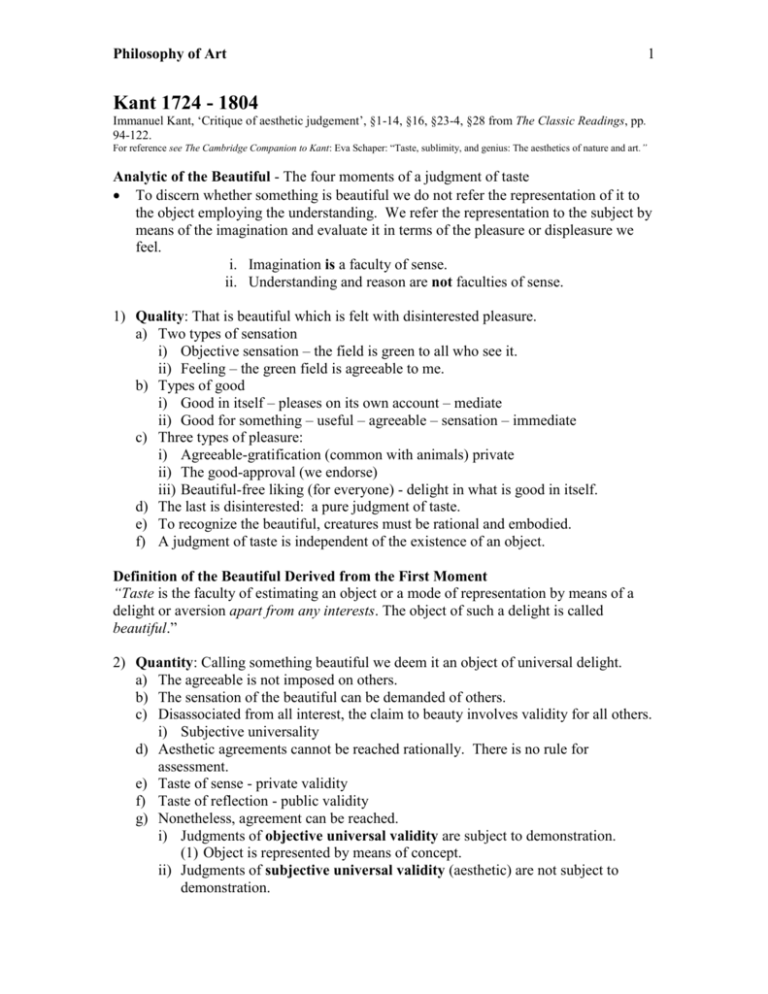
Philosophy of Art 1 Kant 1724 - 1804 Immanuel Kant, ‘Critique of aesthetic judgement’, §1-14, §16, §23-4, §28 from The Classic Readings, pp. 94-122. For reference see The Cambridge Companion to Kant: Eva Schaper: “Taste, sublimity, and genius: The aesthetics of nature and art.” Analytic of the Beautiful - The four moments of a judgment of taste To discern whether something is beautiful we do not refer the representation of it to the object employing the understanding. We refer the representation to the subject by means of the imagination and evaluate it in terms of the pleasure or displeasure we feel. i. Imagination is a faculty of sense. ii. Understanding and reason are not faculties of sense. 1) Quality: That is beautiful which is felt with disinterested pleasure. a) Two types of sensation i) Objective sensation – the field is green to all who see it. ii) Feeling – the green field is agreeable to me. b) Types of good i) Good in itself – pleases on its own account – mediate ii) Good for something – useful – agreeable – sensation – immediate c) Three types of pleasure: i) Agreeable-gratification (common with animals) private ii) The good-approval (we endorse) iii) Beautiful-free liking (for everyone) - delight in what is good in itself. d) The last is disinterested: a pure judgment of taste. e) To recognize the beautiful, creatures must be rational and embodied. f) A judgment of taste is independent of the existence of an object. Definition of the Beautiful Derived from the First Moment “Taste is the faculty of estimating an object or a mode of representation by means of a delight or aversion apart from any interests. The object of such a delight is called beautiful.” 2) Quantity: Calling something beautiful we deem it an object of universal delight. a) The agreeable is not imposed on others. b) The sensation of the beautiful can be demanded of others. c) Disassociated from all interest, the claim to beauty involves validity for all others. i) Subjective universality d) Aesthetic agreements cannot be reached rationally. There is no rule for assessment. e) Taste of sense - private validity f) Taste of reflection - public validity g) Nonetheless, agreement can be reached. i) Judgments of objective universal validity are subject to demonstration. (1) Object is represented by means of concept. ii) Judgments of subjective universal validity (aesthetic) are not subject to demonstration. Philosophy of Art 2 (1) Judgment does not rest on a concept. h) “The cognitive powers brought into play by [a representation to cognition in general] are here engaged in a free play, since no definite concept restricts them to a particular rule of cognition.” i) The judgment of taste is brought about by the free play of the imagination and the understanding that occurs when they are employed without a determinate concept. 3) Relation: We discern in it “the form of finality perceived without the representation of a purpose.” a) “An end is the object of a concept so far as this concept is regarded as the cause of the object (the real ground of its possibility); and the causality of a concept in respect of its Object is finality.” b) “The consciousness of the causality of a representation in respect of the state of the Subject as one tending to preserve a continuation of that state, may here be said to denote in a general way what is called pleasure; whereas displeasure is that representation which contains the ground for converting the state of the representations into their opposite (for hindering or removing them).” c) The subjective delight we are conscious of apart from any concept, effected by the “bare form of finality,” is capable of universal communication. 4) Modality: We claim not only that it pleases but also that it does so necessarily, and without concepts. The 1st and 3rd moments specify when an experience qualifies for being an experience of the beautiful (disinterested pleasure arising from form of finality). The 2nd and 4th moments deal with universality and necessity respectively. None of the forms are adequate in themselves, but working together, Kant believes he has satisfied the requirements for separating aesthetic experience from other modes of experience. Harmonious interaction between imagination and understanding: Kant says we know a priori that it is possible because it is a necessary condition of the possibility of all empirical knowledge. The possibility of universal communicability of empirical truth confirms this. This is how the form of finality has the appearance of purposiveness or design but without purpose. The role of imagination is normally to supply data for the understanding to synthesize. When subjective finality can be ascribed to a form such that it is pleasing to cognition for its own sake, the imagination enters into free play: self sustaining and harmonious interaction with the understanding, whose normal role is to bring data under the concepts for the sake of action or knowledge. There is a pleasure felt in the free play of understanding and imagination when not employed for cognition. Philosophy of Art 3 Analytic of the Sublime Kant introduces ideas of reason to analysis of the sublime. An idea of reason applies not only to theoretical intellect but also morality. 1) Beauty evokes something like pleasure. The sublime evokes a sterner affect, like respect, called a ‘negative’ pleasure. 2) The sublime does not depend on a sensation. An object cannot effect sublimity. 3) The Sublime depends on a sense of limitlessness evoked by the unimaginably vast (mathematically sublime) or the overwhelmingly powerful (the dynamically sublime). Kant is reading Burke here. a) Mathematically sublime: reason is exalted by enabling us to think of what lies outside the reach of the imagination as a totality (theoretical reason). b) Dynamically sublime: (storm at sea) we are reminded of our worth as moral being in contrast to the weakness of our empirical selves (practical reason). 4) Sublimity resides in the powers of the mind to overcome what could annihilate us. 5) Sublimity transcends sense and understanding, it comes about when theoretical or practical reason arises in us if threatened or overwhelmed by the might of nature. It almost brings us into contact with noumenal reality. Aesthetic Idea §49: “I mean a presentation of the imagination which prompts much thought, but to which no determinate thought whatsoever, i.e., no [determinate] concept, can be adequate.” Dialectic of Aesthetic Judgment - The Antinomy of Taste §56: Thesis: “The judgment of taste is not based upon concepts; for if it were, it would be open to dispute” (proof) Antithesis: “The judgment of taste is based on concepts; for otherwise, despite diversity of judgment, there could be no room even for contention in the matter” (claim binding on others) To resolve this, Kant claims that the illusion of conflict appears because of an equivocation on different types of concepts, ‘determinate’ and ‘indeterminate’ concepts. Kant asserts that indeterminate concepts are of the noumenal realm the ding-an-sich, so we can know nothing of it. The maxims of the sensus communis. 1) Think for yourself. 2) Think from the standpoint of others. 3) Think consistently. Reflective judgment: no concept, particular to universal – mediated through participants. Philosophy of Art ‘Kant,’ Donald W. Crawford, from The Routledge Companion to Aesthetics, 51-64. 4
